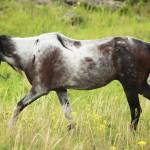Skirting Parasite Resistance with Sainfoin: A Realistic Option?

Due to the global rise in parasite resistance to chemical dewormers, researchers are looking at alternatives. One chemical-free approach to deworming involves the legume sainfoin (Onobrychis viciifolia), which reduces fecal egg shedding of small strongyles and decreases larval motility. Sainfoin is thought to have anthelmintic effects due to concentrated amounts of innate tannin and polyphenol.
Small strongyles, or cyathostomins, are a major threat to horse health. Heavy burdens of these parasites result in lethargy, anemia, weight loss, diarrhea, malabsorption of nutrients, and colic.
“Widespread resistance of small strongyles to commonly used chemical dewormers is reported and cause for great concern. No new deworming agents, known also as anthelmintics, have materialized recently, proving horse owners should be strategic about deworming and implement management practices that can help reduce exposure,” explained Catherine Whitehouse, M.S., a nutrition advisor for Kentucky Equine Research.
Studies in ruminants suggest that nutritional supplementation with sainfoin reduces parasite burdens and egg shedding. To determine if sainfoin exerts similar anthelmintic effects in horses, veterinary scientists recruited 17 horses with similar burdens of small strongyles based on traditional fecal egg count (FEC) techniques. The horses were divided into one of three groups and all were fed meadow hay. In addition to the hay, the control group was fed pelleted wheat bran. The low-dose sainfoin group had half of the pelleted wheat bran replaced with dehydrated sainfoin pellets, and the high-dose sainfoin group consumed dehydrated sainfoin pellets with no pelleted wheat bran. Horses were fed these diets for a total of 84 days.
“During the first period of the study, from days 0 to 28, FECs decreased significantly in the high-dose sainfoin group, suggesting that sainfoin exerts antiparasitic effects,” Whitehouse explained.
The researchers did note, however, that substantial individual variability was observed, meaning that not all horses in the high-dose sainfoin group had equal decreases in FECs.
In the second phase of the study, beginning on day 29, all horses were dewormed with fenbendazole to measure egg reappearance. The goal of this phase was to obtain information on whether or not sainfoin slowed reinfection rates in horses.
Weekly FECs during the second phase of the study found no difference in egg reappearance between the three groups of horses; however, only a 67% in egg reduction was achieved after fenbendazole administration, indicating resistance to this anthelmintic. Thus, the inability of sainfoin to slow egg reappearance following chemical deworming with fenbendazole could be due to the fact that only resistant worms remained after deworming that even sainfoin could not kill.
“Alternatively, the lack of effect of sainfoin on FECs following fenbendazole administration could be connected to an alternate mechanism of action not related to a direct killing effect of sainfoin on cyathostomins,” Whitehouse said.
For example, some studies show that fenbendazole disrupts the hindgut microbiota structure, composition, and function. Fenbendazole may also alter the horse’s immune response to intestinal parasites. Thus, if sainfoin’s deworming properties rely on a well-functioning intestinal microbiome and immune system, then this legume may not be as effective following fenbendazole application.
To maximize and preserve the efficacy of our current chemical dewormers, follow the recommendations made by the American Association of Equine Practitioners under the guidance of your veterinarian.
“This study highlights the importance of a strong immune system and healthy hindgut in managing parasite load. Support digestive health with high-quality forages and digestive aids as needed, such as Kentucky Equine Research’s hindgut buffer EquiShure. In addition, choose concentrates that contain high-quality, bioavailable mineral and vitamin sources to support health and immunity,” advised Whitehouse.
*Grimm, P., N. Laroche, S. Julliand, and G. Sorci. 2022. Inclusion of sainfoin in the diet might alter strongyle infection in naturally infected horses. Animals (Basel) 12(8):955.








